#Bible-based reflection
Explore tagged Tumblr posts
Text
Proverbs Daily Reflection – February 17, 2025
If you thought Captain Jack Sparrow commandeering a ship at the port in Pirates of the Caribbean was daring, you might want to reconsider. Think again. You really need to think again. Consider Robert Smalls's story. Consider the story of Robert Smalls. He did it in real life! #josephmekaelpageministries
Proverbs 17:3 (NKJV) “The refining pot is for silver and the furnace for gold, but the Lord tests the hearts.” Refined Through Fire: Black History & the Fight for Justice The struggles of the civil rights movement were like a refining fire, strengthening those who stood for justice. Many freedom fighters endured trials, but their faith and perseverance shone like purified gold. Unsung Freedom…
#African American Hero#African American history#African American Icons#AME Church#American history#Bible#Bible verse#Bible-based reflection#Biblical Courage#Biblical Wisdom#Black Christian Leaders#Black excellence#Black History Month#Black Legislators#Black Liberation#Blog#Breaking Chains#Charleston Harbor#Christian encouragement#Christian heritage#Christian Influence in Politics#Christian inspiration#Christian leadership#Christian perseverance#Christian Resistance#Christian testimony#civil war#Confederate Ship#Courage and Determination#dailyprompt
0 notes
Text
Lessons from Wander: Loving Without Limits
A part of the “Lessons from [Character Name]” series on TheSweetSelah blog.

Hi friends 💛
Welcome back to TheSweetSelah, where we look for God’s truth in animated stories that inspire and uplift. This post is part of my series called “Lessons from [Character Name]”, where I highlight faith-filled takeaways from some of animation’s most impactful characters.
Today, we’re learning from a character who radiates joy, forgiveness, and unshakable hope: Wander from Wander Over Yonder.
Wander isn’t your typical hero. He doesn’t fight with fists or powers he changes hearts with kindness. He sees the best in people, believes even the worst villains can change, and never gives up on bringing peace, even when it’s easier to walk away.
📖 “But I tell you, love your enemies and pray for those who persecute you.” – Matthew 5:44
Wander lives this verse. He loves boldly, not passively. His compassion isn’t weak, it’s courageous. And we see this clearly in many episodes:
Episode: “The Hero” (Season 1, Ep. 9a)

Wander goes out of his way to let Sir Brad Starlight (an arrogant wannabe hero) take the credit for saving a town, even though Wander did the work. He doesn’t care about recognition—he just wants people to be helped. 📖 Spiritual Parallel: Matthew 6:1 – “Be careful not to practice your righteousness in front of others to be seen by them.”

____
Episode: “The Gift” (Season 1, Ep. 19a)

In this heartwarming (and hilarious) holiday episode, Wander and Sylvia race across the galaxy to deliver presents to everyone they’ve met over the past season. Sylvia thinks their job is done—until Wander insists they also bring gifts to Lord Hater and his army of Watchdogs. Why? Because even villains deserve kindness.
Wander believes that if Hater receives a gift, “his heart might grow three sizes” and he’ll start spreading cheer instead of fear. Despite Sylvia’s complaints, Wander joyfully distributes gifts—even hiding in vents and chimneys to do so. And when the Watchdogs find joy from receiving presents “from Lord Hater” (thanks to Wander’s clever plan), even Hater starts to see the impact of unexpected kindness.
Although Hater initially uses the moment to try to conquer again, his soldiers—and even the “ornament villagers”—end up filled with cheer. Hater is literally buried under a pile of hugs. Wander's mission of selfless love didn’t go as expected… but it still worked.
📖 Galatians 6:9 – “Let us not grow weary in doing good, for at the proper time we will reap a harvest if we do not give up.”
Even when kindness doesn’t seem to “work” in the way we hoped, it still plants seeds. Wander models the kind of persistent, self-giving love that Jesus calls us to—a love that gives freely, even when it’s rejected or misunderstood.

____
Episode: “The Little Guy” (Season 1, Ep. 7a)

In this heartfelt and funny episode, we meet Westley, the tiniest and most overlooked of Lord Hater’s army of Watchdogs. Desperate to prove himself, Westley sets out to capture Wander and Sylvia, hoping to earn Hater’s approval and receive the prestigious “Medal of Evil.” But along the way, something unexpected happens—he meets kindness.
Wander doesn’t mock Westley’s size or ambition. Instead, he sees the small Watchdog’s potential, treating him with patience, encouragement, and even friendship. As they travel together, Westley slowly begins to see the world differently—witnessing joy, generosity, and the power of gentleness. He starts softening, even though he constantly fights it.
One of the most touching moments is when Wander and Sylvia offer Westley soup by a warm fire, expecting nothing in return. Westley assumes the worst, only to discover sincere love and safety. It’s in that quiet moment—wearing borrowed pajamas, warmed by the fire—that he begins to feel what it’s like to be seen, not for his usefulness or rank, but for who he is.
📖 1 Samuel 16:7 – “The Lord does not look at the things people look at. People look at the outward appearance, but the Lord looks at the heart.”
Despite returning Wander and Sylvia to Lord Hater in the end, Westley can’t ignore what he’s experienced. He stages a fake explosion, fakes his own “demise,” and escapes the ship to quietly walk a new path. Reunited with Wander and Sylvia, he performs his first good deed by feeding a squirrel and receives his own star-covered hat—a symbol of his transformation.
📖 Matthew 5:16 – “Let your light shine before others, that they may see your good deeds and glorify your Father in heaven.”

____
🌟 Takeaways:
Wander teaches us that love isn’t loud—it’s consistent. He reminds us that kindness is a calling, not a personality trait. And in a world where bitterness and revenge are expected, Wander overcomes with joy.
Whether you're facing a tough relationship, conflict, or a world that feels hostile… be like Wander. Choose joy. Choose mercy. Choose love.
📖 “So whether you eat or drink or whatever you do, do it all for the glory of God.” – 1 Corinthians 10:31

🩷 Stay blessed, stay bold in love, and keep looking for God's heart in every frame.
~Sweet Selah
#wander over yonder#westley watchdog#lord hater#wander and sylvia#disney xd#cartoon character growth#animation analysis#underrated cartoons#cartoons with heart#animated storytelling#christian blog#faith based blog#bible inspired#animation with meaning#christian perspective#god in media#anime with a message#cartoons and christ#faith in fiction#christian creativity#character study#anime character reflection#scripture and storytelling#bible themes in animation#grace in action#christlike love#anime morality#christian values#spiritual growth#faithful characters
17 notes
·
View notes
Text
re: cocoposting, you might be like, "horse, isn't foucault's 'care of the self' about classical attitudes around (homo)sexuality?" and you're right, it's not about america at all, except i've done a LOT of early american history shit (happens when you write a diss chapter on 'hamilton') and foucault weirdly clarified for me how 18th c anglos understood sex/relationships as this extension of their understanding of what "republics" signified and the rights of the (State-sanctioned/legible) Human
#there's also some sylvia wynter doing a lot of heavy lifting for me in here#but the point is that...it's less about the REALITY of the ancient world and more about how a predominantly protestant english-speaking#''world'' UNDERSTOOD those texts and translations and what they fixed them to mean in relation to OTHER ancient texts#like the christian bible circa kjv#which is all to say at some point ''corinthian'' stops signifying the ancient city of corinth and whatever cultural practices he might#reflect and instead OUR perception of ''corinth'' which is heavily based on english translations of the pauline epistles#and classical texts that have gone through SEVERAL rounds of translation and debate#so that at the end of the day plato is saying what you want him to say#i.e. justification for colonial separatism and u.s. white supremacy#posts that are like. for alf.
4 notes
·
View notes
Text
When Seeing Still Isn’t Believing
A Year in the Life of Jesus Some requests sound spiritual on the surface but reveal something darker underneath. That’s what we see in Matthew 12:38–42, where some of the Pharisees and teachers of the law approach Jesus with what seems to be a harmless request: “Teacher, we want to see a sign from you.” Sounds reasonable, right? After all, He’s been healing the sick, casting out demons, and…
#apologetics#biblical reflection#Christian devotion#Craig Blomberg#daily spiritual blog#death and resurrection of Christ#gospel evidence#gospel-based living#intentional faith#Jesus and the Pharisees#Jesus and unbelief#Jesus greater than Solomon#Jesus&039; resurrection#Jonah and Nineveh#Matthew 12:38–42#miracles in the Bible#Pastor Hogg#Pharisees demand a sign#proof of resurrection#Queen of Sheba#R.T. France#seeking miracles#sign of Jonah#signs and faith#spiritual blindness#spiritual pride#theological blog#year with Jesus
0 notes
Text
Understanding Paul’s Message in 1 Corinthians
by Ariel Hey there, awesome friends! It’s Ariel, and I can’t wait to tell you about something super cool that our family has been discovering together! Have you ever thought about what it means to be part of something really big, like a superhero team? Well, that’s what Paul talks about in 1 Corinthians 1:1-9, and trust me, it’s like getting a giant, cozy hug that makes you feel amazing! In…
#Bible inspiration#biblical truth#Christian encouragement#Christian identity#Christian living#Christian reflection#Christian spirituality#discovering grace#exploring Christianity#faith and grace#faith blog#faith inspiration#faith journey#faith-based living#finding purpose#God’s purpose#grace of God#grace-filled life#identity in Christ#journey in faith#living in Christ#spiritual discovery#spiritual growth#spiritual identity#understanding salvation
0 notes
Text
Breathing Away the Heavy: A Journey to Lightness
Life has a way of piling on weight—burdens we carry in our hearts, minds, and bodies. Stress, worry, guilt, and fear can make us feel as though we’re trapped under layers we can’t escape. But in those moments of heaviness, God invites us to breathe, release, and find rest in Him. The Bible offers us a promise of relief: “Come to me, all who labor and are heavy laden, and I will give you rest.…

View On WordPress
#Bible-based meditation#breathing exercise#calming breath#Christian mindfulness#emotional healing#faith and peace#finding lightness#gratitude.#guided meditation#inner peace#journey to lightness.#letting go#Matthew 11:28-30#meditation#releasing burdens#rest in God#spiritual journey#spiritual practice#spiritual reflection#stress relief
0 notes
Text
Understanding Divine Forgiveness in Christianity
Forgiveness is a cornerstone of Christian faith, ensuring a path to reconciliation and peace. It's something we're called to extend to others and receive ourselves. This principle is found throughout scripture, offering hope and healing. But what does it
Forgiveness and Divine Forgetfulness: A Biblical Promise Forgiveness is a transformative power that echoes throughout spiritual teachings, most notably in D&C 58:42, which assures us that once we repent, God no longer remembers our sins. This promise of divine amnesia underscores the profound love and grace He extends to us. As imperfect beings, we often hold onto guilt and shame, unable to…
#Bible lessons#Bible study#biblical promise#Christian beliefs#Christian teachings#church teachings#divine forgetfulness#faith journey#faith-based learning#Forgiveness#forgiveness in Christianity#God’s forgiveness#God’s love#grace and mercy#healing through faith#New Testament#Old Testament#Redemption#religious faith#religious reflection#scriptural insights#Spiritual Growth#Spiritual Guidance#Spiritual renewal#Spiritual Transformation#understanding forgiveness
0 notes
Text
youtube
#make it 50 words#FaithInAction#Christian inspiration#Faith-based content#Spiritual growth#Biblical teachings#Inspirational messages#Encouragement#Gospel reflections#Christian life#Devotional insights#Prayer and worship#Christian community#Faith journey#Healing and hope#Bible study#Positive faith#God's love#Testimonies#Scripture study#Christian values#Serenity and faith#Remember#User#ChatGPT#Biblical insights#HealingJourney#DivineRestoration#make it 20 words
1 note
·
View note
Text




Bible Mod By Nimalusims
Bring faith to your Sims' world 📖✨ With the Bible mod, your Sims can now read scripture, reflect, and grow spiritually! Just like in real life.
Base Game Compatible
Emotional Buffs
Download
Join My Sims 4 Community That Is A Facebook Look Alike

www.nimalusims.com
#the sims#sims 4#maxis match#ts4 legacy#showusyoursims#sims 4 cc#ts4 maxis match#the sims 4#ts4#sims 4 screenshots#sims 4 bible#sims 4 bible mod#sims 4 bible reading
284 notes
·
View notes
Text
Proverbs Daily Reflection – January 30, 2025
Proverbs 3:7 (KJV) reminds us: "Be not wise in thine own eyes: fear the Lord, and depart from evil." #josephmekaelpageministries
The Danger of Self-Righteousness: Washed or Justifying Our Filth? “There is a generation that are pure in their own eyes, and yet is not washed from their filthiness.” – Proverbs 30:12 (KJV) Introduction: Self-righteousness is one of the most dangerous spiritual deceptions. It blinds a person into thinking they are clean while still living in rebellion against God. Many claim to be righteous…
#JosephMekaelPage#avoiding spiritual blindness#Bible#Bible-based reflection#Biblical Truth#Biblical Wisdom#Blog#breaking deception#Christian Reflection#Christian self-examination#Christian transformation#cleansing from sin#daily repentance#dailyprompt#dangers of self-justification#faith#faith and obedience#faith and purity#false righteousness#God#God’s mercy and grace#gospel message#heart examination#Holy Spirit conviction#humility before God#Jesus#Jesus cleanses sin#Joseph#Joseph Mekael Page#Joseph mekael page ministries
0 notes
Text
Verses That Match This Scene: Zuko’s Apology to Uncle Iroh
A part of the “Verses That Match This Scene” series on TheSweetSelah blog.

Hi friend 💛
Welcome back to TheSweetSelah, where faith meets animation and God’s truth shines through the most unexpected moments. This post is part of my “Verses That Match This Scene” series—where I reflect on powerful scenes in animation and pair them with scripture that speaks directly to the heart.
____
Episode: Sozin’s Comet, Part 2: The Old Masters

The Scene: Zuko’s Apology to Iroh

Zuko has betrayed his beloved uncle more than once. He chose power over love. Pride over humility. But in this moment, broken and changed, he enters Iroh’s tent—unsure if forgiveness is possible. When Iroh wakes, Zuko begins to cry, barely able to speak through the guilt.
“I’m so sorry, Uncle. I’m so sorry and ashamed of what I did.”
Before he can say anything else, Iroh embraces him with tears.
“I was never angry with you. I was sad, because I was afraid you had lost your way.”
Zuko had expected punishment. But instead, he received grace.
📖 “But while he was still a long way off, his father saw him and was filled with compassion for him; he ran to his son, threw his arms around him and kissed him.” - Luke 15:20
Zuko’s moment mirrors the parable of the prodigal son. In Luke 15, Jesus describes a father who welcomes his lost son—not with judgment, but with celebration. That’s what we see here. Iroh doesn’t need an explanation. He just needs to hold the boy he never stopped loving.
Like Zuko, we may carry regret for what we’ve done. But God doesn’t wait to punish us. He’s waiting to embrace us the moment we turn back.
____
🌟 Takeaways:
God doesn’t shame you. He welcomes you. Like Iroh, He already sees your heart.
Forgiveness is a gift, not a transaction. You don’t earn it—you receive it.
Your past doesn’t disqualify you from returning home.
Maybe today, like Zuko, you feel like you’ve gone too far. But grace doesn’t have a limit. There’s always room to come back.
📖 “So whether you eat or drink or whatever you do, do it all for the glory of God.” – 1 Corinthians 10:31

🩷 Stay blessed, stay open to grace, and keep your eyes on God’s light in every frame.
~Sweet Selah
#verses that match this scene#zuko and iroh#prodigal son#avatar the last airbender#sozins comet#faith in animation#grace in storytelling#bible inspired#christian reflections#the sweet selah#God forgives#animated by grace#christian blog#faith based blog#animation with meaning#christian perspective#God in media#anime with a message#cartoons and christ#faith in fiction#christian creativity#atla zuko#prince zuko#the gaang#atla#iron
11 notes
·
View notes
Note
Heya! I've been following you for a bit and you keep mentioning musicals I've never even heard of! I'm a musical theater teacher so I'm always looking for new musicals, specifically I'm looking for good solos for my students.
Do you have any recs? Feel free to put musicals but also specific songs . Thanks!
Oh you have open a floodgates! Time for me to share all my musical craze!
But let's start with ALL BIBLICAL MUSICAL FIRST! XD
Beloved King: A Queer Bible Musical My first musical animatic was from this musical, Beloved King! It's a queer and romantic retelling of the story of David and Jonathan from the Bible. It's not out yet, and there is only a collection of six songs available right now. My favorite song is Adoni! Concept Album
King David This musical is also based on David from the Bible, but it tells his whole life, focusing more on David's and King Saul's relationship in the first act. The second act is like a forbidden consensual lovers' romance between David and Bathsheba.... Sigh... Pretty disapointed there. The music is really good, though! It have this Disney vibes but darker. Well, it is Alan Menken, so it makes sense that this musical reminds you of every Disney Renaissance movie ever. Fave solos... "The Enemy Within" and "Never Again" Playlist
David - Sight & Sound Theathers So Sight & Sound Theaters are this religious, high-budget company that makes the utmost amazing and spectacular shows. I saw the musical Daniel, so I can guarantee that the show, props, and effects Sight & Sound has are amazing. And the music is amazing as well! It is kind of funny, though, that in this musical they actually depict David's relationship with Bathsheba as… well, not romantic compared to Tim and Alan's musical. There are a bunch of great songs in this, but my favorites would be… "Learning to Shepherd," "David Spares Saul," and "Psalm 24." Playlist
David Et Jonathas A French opera from 1688 by Charpentier. If "Beloved King" is explicitly queer, then "David et Jonathan" is romantically queer. Because this opera is so romantic and tragic, it freaking made me cry. BEST SONGS: "A vostre bras vainqueur," "Vous me fuiez!" and "Qu'on sauve Jonathas." Full Album
Daniel - Sight & Sound Theathers This musical is based on the story of Daniel from the Bible. Daniel was a Jewish young man who was taken by the Babylonian king Nebuchadnezzar to become his dream interpreter, and then a lot of stuff happens. I saw this musical in Lancaster, and it was amazing. My biggest criticism is that the story is rushed to the maximum. There are a lot of songs I love from this one, but if I had to pick my three favorites, they would be "Where You Are," "Cry for Home," and "New Wind (Ezekiel's Song)." To be honest, I love almost every single one of them… Playlist
Queen Esther - Sight & Sound Theathers Just like every single Sight & Sound Theaters musical, this one is also based on the Bible, and it's about Queen Esther. Kind of similar to Daniel, she was a young Jewish woman, among many others, who was taken by the Persian King Ahasuerus. Because she was so smoking hot, the king made her his queen, and then a lot of stuff happens. The music in this one is pretty okay for me. I do like "Reflections of Persia" and "Esther's First Banquet." Playlist
Of Ashes This is the last musical recommendation that is based on a biblical story! I PROMISE! So this story is about Ashra, the woman who was caught in adultery by religious leaders, and Matthias, the man with leprosy. The music here is very much my vibe, very dramatic, but there are a lot of great solos and duets here. For solos, it is "Everybody's Lover" and "Beautiful Death." And for duets, "Three Months Ago" and "Colors." Full Album
Time for the greek myth based musicals!
Stories From Styx It's an anthology musical series where each song narrates a Greek myth story set in the underworld. The first album focuses on Hades and Persephone. The second will be released soon! Stories From Styx: Hades & Persephone Album
Paris The Musical Paris is a rock musical by Jon English and David Mackay from 1987, and it's based on the myth of the Trojan War, focusing on the romance and tragedy of Paris and Helen. The vocals are so beautiful, and I just love how Helen is portrayed in this adaptation. She is in love with Paris, but at the same time, she suffers and is in despair over what is happening. Favorite songs: "Perfect Stranger," "Business," "Any Fool Could See," and "Hell or High Water." Playlist
Epic The Musical .... Y'all already know what it is.
And the other musicals!
Returns of the Moon Yet to be released, but I thought I could share it! >:D It's about a witch who's going to be executed, and when she's about to die, she uses the moon's power to resurrect people murdered in their past lives. These resurrected main characters, now trapped in an unfamiliar time period and place, must work together to find the witch, avoid witch-fearing hunters, and confront what happened during their past lives. Teaser
Venice Venice is a musical by Matt Sax and Eric Rosen. It takes place in the fictional city of Venice, which has been at war for a generation. Venice Monroe, named for the city, is sworn in as the new leader, promising to bring change to society. If you enjoy hip-hop music, then this is a highly recommended show! Playlist
Warriors So this is a concept musical by Eisa Davis and Lin-Manuel Miranda. And yes… IT'S FREAKING FANTASTIC! This musical was inspired by the 1979 action film The Warriors, which adapted the 1965 novel of the same name. I think I actually love all the songs on this album, but gosh, if I have to pick, then it would be "Derailed," "Leave the Bronx Alive," "Call Me Mercy," and "The Park at Night." Playlist
Notre Dame De Paris The Musical So I was obsessed with this musical for years, and the guy who plays Quasimodo… Mmwhaaa! This French musical is based on the classic The Hunchback of Notre-Dame by Victor Hugo. Do I really have to point out which are my faves? It’s obviously "Belle" and "Danse Mon Esmeralda"! Playlist
Outlander This is a musical from 2010, based on the book Outlander by Diana Gabaldon. It's about Claire Randall, a World War II nurse who mysteriously travels back in time to 18th-century Scotland. There, she encounters and falls in love with a warrior, Jamie Fraser. <3 So I think this will make me a villain for recommending this because this is seriously a musical that is almost a lost media... I think. Kind of, because the thing is… I literally stalked the producer and contacted them to see if I could buy a CD or even just the MP4 files for the whole musical. AND THE PRODUCER ANSWERED ME, AND I GOT TO BUY A CD! So years ago, this musical was available on Spotify, but then it was removed, which led me to do this search in the first place. Either way, I think the only available material from this musical here online is this playlist…. I think it is possible to still buy the CD but Im not sure anymore T.T ....maybe I can share a drive link or something.... Either way, my favorite songs from this musical are "Falling," "Farewell (I Am Ready Reprise)," and "Ellen's Son."
#asks#musical recs#beloved king a queer bible musical#epic the musical#venice musical#warriors musical#stories from styx#sight and sound theaters#of ashes musical#paris the musical#outlander the musical#aka a bunch of musical tags XD
321 notes
·
View notes
Text
A case of twice-mistaken identity: on “Asherah” in Strange Journey
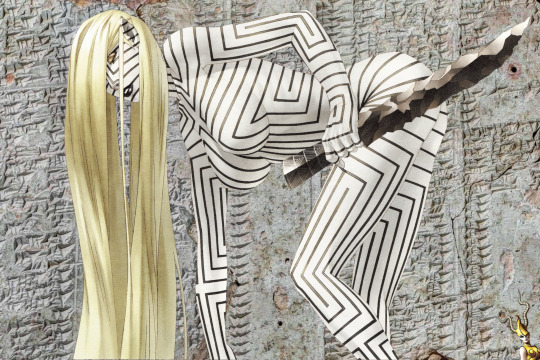
In 2009, Atlus released one of their most unique games to date - Strange Journey, an rpg set in a deliberately unrealistic setting in which demons exist, while the UN does something beyond issuing a non-binding resolution in the face of crisis. In contrast with many of the previous SMT installments, Strange Journey only introduced a handful of new demons. They were some of the last designs Kazuma Kaneko provided for the franchise, but most of them became instant fan-favorites, sparking a veritable avalanche of fanart (by Megaten demon standards, at least) and endless discussion. Going by the raw numbers on pixiv and similar sites, the consensus view seems to be that the standout among them is the “protagonist” of this article, seen above. The English translation of the game, as well as official English translations of all subsequent Megaten media, opted to romanize the name of the discussed entity as Asherah. I have a strong reason to suspect this is wrong, and that “Asherah” is not who most of us assumed she is on this basis. In this article, I will explain the origin of the term asherah and examine if it was ever the name of a deity. I’ll also look through its cognates in multiple languages. Finally, every Megaten fan’s favorite fringe tome will be consulted for additional hints. As a result, the true identity of “Asherah” shall be revealed.
“A horrid thing”: the asherah in the Bible and related sources
The term asherah appears in the Bible, though it’s actually up for debate if it can be interpreted as the name of a deity (Steve A. Wiggins, A Reassessment of Asherah With Further Considerations of the Goddess, p.105). Ignoring occasional modern attempts at emending passages which do not require that, it occurs forty times in scriptural sources (A Reassessment…, p. 110). Nearly all of them point to the asherah being some variety of cultic object. In some cases a plural form is given, though the grammatical gender is inconsistent, with examples of both asherot (Judges 3:7) and asherim (1 Kings 14.23; 2 Kings 17.10; 23.14). The masculine variant is more common, which makes it unlikely the singular form was particularly commonly viewed as a feminine noun - unless, perhaps, the compilers considered an intentionally ungrammatical plural some sort of irony (A Reassessment…, p. 110-111).
Most of the references are fairly formulaic, and occur in passages from books belonging to the tradition of “Deuteronomistic History” explaining why Yahweh became angry with the kingdoms of Israel and Judah. In those cases the anger appears to be tied to placing one or more asherah in the proximity of an altar. Based on the fact that an asherah could be planted, and destroying it was typically accomplished by burning or hewing, most likely they should be understood as wooden objects (A Reassessment…, p. 111-112). Nothing more can be established with certainty, and in absence of precise descriptions labeling any objects recovered from excavations as examples just because they’re wooden should be avoided (A Reassessment…, p. 261).
A possible reference to Asherah understood as a foreign deity might be present in 1 Kings 18:19, where “400 prophets of Asherah” are among Jezebel’s associates singled out by the prophet Elijah (A Reassessment…, p. 127-129). However, it is implausible that this reflects historical reality. Jezebel hailed from Tyre and no deity bearing an even barely similar name is attested in the local pantheon of Tyre - or, for that matter, in any other Phoenician city in the Iron Age (Spencer J. Allen, The Splintered Divine. A Study of Ištar, Baal, and Yahweh. Divine Names and Divine Multiplicity in the Ancient Near East, p. 280).
A further example might be 2 Chronicles 15:16, where at least according to the Masoretes Asherah is used as a personal name. The passage deals with the deposing of queen mother (gebirah) Maakah by king Asa of Judah after she created an unspecified “horrid thing” for Asherah - or, if the Masoretes were incorrect, perhaps created an asherah, a “horrid thing”, for herself (A Reassessment…, p. 125-126).
Rabbinic tradition generally considers the asherah to be a type of tree (A Reassessment…, p. 148-149). Similarly, the Septuagint (and by extension other translations derived from it) renders the plural form of this term as “groves” (A Reassessment…, p. 269). While especially in the 1990s it was common to argue that the hypothetical namesake goddess must have been some sort of tree deity as a result (A Reassessment…, p. 239), no evidence in favor of this interpretation is available (A Reassessment…, p. 261-263). In the end, the supposed arboreal Asherah is little more than a result of overinterpreting a historical guess about the meaning of a term whose original context was entirely lost by the first centuries CE (A Reassessment…, p. 269).

A decorated pithos from Kuntillet Arjud (wikimedia commons)
As far as extrabiblical materials go, the most relevant source offering some further hints about asherah are two early first millennium BCE Hebrew inscriptions from Kuntillet Ajrud in Egypt which mention blessing someone by “Yahweh of Teman and his asherah” and “Yahweh of Samaria and his asherah” (The Splintered Divine…, p. 265). It’s up for debate if “Yahweh of Samaria” and “Yahweh of Teman” were understood as two fully separate deities - the way, say, Ishtar of Nineveh and Ishtar of Arbela were in Mesopotamia - or simply as two regional manifestations of the same deity (The Splintered Divine…, p. 272). The fact that similar formulas find no other parallels in any other texts in Hebrew doesn’t help (A Reassessment…, p. 204). This is ultimately outside the scope of this article, though.
What matters for the discussed subject is that the original publication of the Kuntillet Ajrud material in 1979 sparked what by the early 2000s came to be referred as an “Asherah boom” or “Asherah craze” (Izak Cornelius, The Many Faces of the Goddess: The Iconography of the Syro-Palestinian Goddesses Anat, Astarte, Qedeshet, and Asherah c. 1500-1000 BCE, p. 3).
Crucially, the inscriptions were commonly held as evidence that Yahweh had a wife, and that she was named Asherah (A Reassessment…, p. 190). Nothing explicitly indicates that their authors considered asherah to be the name of a goddess, though (The Splintered Divine…, p. 309).
It is entirely possible that the familiar wooden cultic object is meant (A Reassessment…, p. 198). We might be dealing with a formula similar to Eliezer’s considerably later) invocation of the altar of the Second Temple alongside Yahweh, which obviously does not indicate that he treated a piece of furniture as an independent deity (The Splintered Divine…, p. 309). It might also be worth noting that an asherah was made for Yahweh in Samaria under king Omri’s orders, according to 1 Kings 16:33 (The Splintered Divine…, p. 278).
It should be noted that while one of the inscriptions is accompanied by a drawing (as seen on on the illustration above), it is unlikely to be related to its contents (A Reassessment…, p. 199-200).
It has been argued that a further reference to “Yahweh and his asherah” occurs in a roughly contemporary funerary inscription found in Khirbet el-Qôm in the West Bank, though the poor preservation of the text makes any translations tentative. It cannot thus be used to argue even for a link between Yahweh and the cultic object asherah, let alone for the existence of a goddess named Asherah (A Reassessment…, p. 190-196). It has been argued that it is effectively a Rorschach test of sorts for a given author’s views about the asherah and Asherah (A Reassessment…, p. 274). Ultimately it’s difficult to evaluate if Yahweh ever had a wife, let alone if that wife was named Asherah. If that was the case, it’s hard to disagree that the archeological evidence is beyond sparse, though (A Reassessment…, p. 281).
Looking at material from other nearby areas from the first millennium BCE does not provide any further evidence for a goddess named Asherah. The Phoenician term ʾšrt, which is likely a cognate of asherah, has a handful of attestations (one inscription each from Umm El-Amed, Acre and Pyrgi), but invariably refers to a place - presumably a (type of) shrine or sanctuary - not to a goddess (A Reassessment…, p. 212-214). An alleged Phoenician attestation of Asherah on an amulet from Arslan Tash seems to actually be a reference to the Assyrian head god Ashur, and the object might be a forgery anyway, which would render it virtually worthless as a source (A Reassessment…, p. 210-212).
The supposed Aramaic evidence is even more flimsy. An alleged reference to Asherah (ʾšyrʾ) on a fifth century stela from Tema turned out to be a misreading, with a local deity named ʾšymʾ actually meant. A stela from Sefire does affirm that a cognate, ʾsrt, was used to designate a type of sanctuary, much like in Phoenician, though (A Reassessment…, p. 214-215).
“Lady of the sea”: Athirat in Ugarit
If the evidence for the biblical asherah being a theonym, rather than a term, is flimsy at best, where does the idea that a deity with an identical name existed? To find an answer, we need to travel a few centuries further back than the oldest material discussed in the previous section.
In the early twentieth century, excavations in Ras Shamra in nothwestern Syria revealed that this site was originally a Bronze Age city, Ugarit - and that the local pantheon included Athirat, whose name was suspiciously close to a biblical term for some sort of cultic implement (A Reassessment…, p. 225).
It needs to be stressed that the information from Ugarit cannot be transferred to areas further south in different time periods (The Many Faces…, p. 18). Also, in particular the labeling of Ugarit as “Canaanite” - very common online - should be avoided. It was not located in Canaan - this label only applied to the area more or less from Byblos to Gaza (The Many Faces…, p. 8); it belonged to the circle of Amorite culture (Dennis Pardee, Ritual and Cult at Ugarit, p. 236).
With that in mind, let’s look at Athirat. Her name is undeniably a cognate of the biblical term and its Phoenician and Aramaic analogs. It might very well be that the word originally meant “holy place” or “sanctuary”, and that a theonym developed from it, rather than the other way around (A Reassessment…, p. 221-222). It’s worth stressing right away that Ugarit provides by far the most references to any of the cognate terms which are the subject of this inquiry - Athirat is, ultimately, better attested than asherah (A Reassessment…, p. 105).

Tablet with a section of the Baal Cycle (wikimedia commons)
Athirat is arguably best known from, and most prominent in, the Baal Cycle (A Reassessment…, p. 33). She first appears in the section dealing with the conflict between Baal and Yam, the sea god, though her precise role in the relevant passage is uncertain. She might be involved in providing Yam with a new name or title (A Reassessment…, p. 34-42). Her role in the second of the three sections, which deals with the construction of a palace for Baal, is much better understood. Baal and his ally Anat convince her to mediate with El, her husband, so that Baal can have a house built for himself. Athirat doesn’t appear to be fond of them (in fact, at first she assumes they want to fight her), and convincing her requires numerous gifts provided by the craftsman god Kothar-wa-Khasis. It’s possible Yam, despite already being defeated by Baal earlier, is also present in this scene, and that Athirat temporarily restrains him with a net while her negotiations are ongoing (A Reassessment…, p. 42-74). Athirat makes her final appearance in the third part of the cycle, in which Baal temporarily dies at the hands of Mot. The implied hostility between her and Baal seemingly resurfaces, as Anat remarks that she will surely rejoice after hearing about his untimely demise. El tasks her with appointing a replacement, which she promptly does, choosing Attar to act as a new king of the gods. She seems to be so enthusiastic about this that it has been suggested that it is this opportunity to show off her position this way that’s the cause of her good mood, as opposed to Baal’s death (A Reassessment…, p. 75-77). Athirat’s role is overall less prominent in other literary texts in which she appears. These include the Epic of Keret (A Reassessment…, p. 25-33); Shachar and Shalim (A Reassessment…, p. 86-92); and a variety of shorter or fragmentary compositions (A Reassessment…, p. 92-98). She only occurs with a limited frequency in sources tied to the sphere of cult (A Reassessment…, p. 274).
While none of the Ugaritic texts make that explicit, it can be safely assumed that Athirat was regarded as the wife of El, the head of the pantheon (The Many Faces…, p. 99). Nothing indicates she played this role vis a vis Baal (A Reassessment…, p. 84). The only cases where they occur side by side are offering lists, and this is ultimately as informative when it comes to determining the connection between them as a modern church named jointly after, say, St. Andrew and St. George is for establishing the personal connections of the respective saints (A Reassessment…, p. 101)
El and Athirat have a variety of matching titles, designating them as senior members of the pantheon and creator deities - while El is the “father” and “creator” of the gods, Athirat is accordingly the “mother” and “creatress” (Aicha Rahmouni, Divine Epithets in the Ugaritic Alphabetic Texts, p. 331). The former title only appears once in the entire corpus (Divine Epithets…, p. 73), the latter - six times (Divine Epithets…, p. 276-277).
It needs to be stressed that the “maternal” titles do not designate Athirat as some sort of Frazerian “Great Mother”. They are a reflection of status: she is a creator deity, and a senior member of the pantheon, but not some transcendent all-encompassing ur-mother (A Reassessment…, p. 237). Simply put, she does not represent the popcultural image of a “mother goddess” (A Reassessment…, p. 83-84; The Many Faces…, p. 99).
It is perhaps best to describe Athirat as the divine counterpart of a queen mother, going by her portrayal in the Baal Cycle, especially her role in the appointment of a new king of the gods. It has been argued that her title rbt might specifically reflect this role, judging from the context in which its Akkadian cognate rabītu was used in Ugarit (A Reassessment…, p. 77-78). However, since the sun goddess Shapash is also designated as a rbt, this might be incorrect, at least as far as epithets of deities go (Divine Epithets…, p. 281-282). Athirat’s high status is also reflected by her placement in a trilingual god list based on the Mesopotamian Weidner god list, with Hurrian and Ugaritic columns added. It establishes an equivalence between her, Ninlil and “Ašte Kumurbineve” (Aaron Tugendhaft, Gods on Clay: Ancient Near Eastern Scholarly Practices and the History of Religions, p. 175). The former’s character was similar. She was the wife of a pantheon head, and the epithets highlighting her status similarly refer to her as the “mother” (ummi) or “creatress” (bānīt) of the gods (Divine Epithets…, p. 73). The latter is actually a pure scribal invention, though - the name simply means “Kumarbi’s wife”. No such a goddess was actually worshiped anywhere, she was invented entirely for completeness’ sake (Gods on Clay…, p. 177-178).

Yam (“Ym”), as portrayed in Shin Megami Tensei (MT wiki, via VeskScans)
Seniority is not Athirat’s only characteristic. Her most common epithet is actually “lady of the sea”, which occurs twenty-one times total - all of those attestations are from the Baal Cycle, though (Divine Epithets…, p. 281). While it contains the same word for sea - ym - as the one which doubled as a theonym, it is agreed that an ordinary body of water is meant in this case, not the sea god par excellence, Yam (Divine Epithets…, p. 284-285). Steve A. Wiggins suggests that the title might be a reference to some hitherto unknown tradition about Athirat’s origin, as opposed to an indication of involvement in unspecified marine matters. While this proposal is interesting, it ultimately remains entirely speculative (A Reassessment…, p. 273). Athirat’s presumed association with the sea might explain why a minor deity consistently described as her servant, Qudshu-wa-Amrur, is addressed as her fisherman (Divine Epithets…, p. 150-151). A further deity defined by a connection to Athirat is Dimgay, her handmaiden, though she is much more sparsely attested (and has no aquatic associations). In the sole text to mention her she is paired with Tallish, who fulfills an analogous role in the court of the moon god Yarikh (Divine Epithets…, p. 78-79).
Excursus 1: the illusory triple A goddess(es)

Anat (right) and her #1 fan, pharaoh Ramses II (wikimedia commons)
While Athirat’s connections with El and with her servants are well documented, a common misconception, repeated especially commonly in older scholarship, but also online, is that she, Anat and Ashtart were associated with each other so closely they basically formed a group. As an extension, the three of them are presented as the only major goddesses in Ugarit (and beyond). However, this grouping is both modern and entirely artificial. It’s worth noting that as far as the Ugaritic evidence goes, Shapash, the sun goddess, was actually comparably, if not more, important as Ashtart (A Reassessment…, p. 230).
Nonetheless, at least among Bible scholars it’s possible to find examples of complete and utter credulity leading to presenting Athirat, Anat and Ashtart as not just closely related, but somehow interchangeable (A Reassessment…, p. 283). Typically questionable publications aim to present Athirat and Ashtart as somehow identical or at least conflated with each other. This is based entirely on the superficial similarity of their Romanized names - they were not very similar in Ugaritic, seeing as one begins with an aleph and the other with an ayin. Ashtart doesn’t even appear in parallel with Athirat; if she is paired with another goddess, it’s Anat (A Reassesment…, p. 57). However, while Anat and Ashtart did share multiple characteristics, even they were not conflated with each other (The Many Faces…, p. 100), let alone with Athirat.

A typical depiction of Qadesh (middle), accompanied by Min (left) and Resheph (wikimedia commons)
Despite lacking any strong foundation in reality, the “triple A” misconception managed to influence early scholarship pertaining to a fourth deity - one who doesn’t even have anything to do with Ugarit, at that. Starting with the 1930s, the idea that the goddess Qadesh must be one and the same as “Asherah” arose. This rested on two far reaching conclusions: that if Qadesh appears with Anat and Ashtart in a single inscription, she must be a foreign goddess of comparable importance; and that qdš (“blessed”) was an epithet of Athirat in Ugarit (A Reassessment…, p. 226).
The first problem is that the sole source to group Qadesh with Anat and Ashtart - the so-called Winchester College stela - is nowhere to be found today. It has been lost at least since the 1990s, if not earlier (A Reassessment…, p. 229). It’s not entirely impossible that it was a fake, since back when it was still accessible to researchers in the 1950s it has been pointed out that the artist had an oddly poor grasp of the hieroglyphic script (The Many Faces…, p. 95).
There is also no evidence that qdš was a title of Athirat (A Reassessment…, p. 226). It does occur as a title of El in the Epic of Keret, though, and is actually grammatically masculine (A Reassessment…, p. 227). Alas, I don’t think anyone is bold enough to suggest Qadesh is El’s drag persona.
A further issue is that while no certain examples of depictions of Athirat have been identified, textual sources indicate she would in all due likeness look considerably less youthful than Qadesh does (The Many Faces…, p. 100). Considering all of these serious obstacles, it should come as no surprise that identifying Qadesh as Athirat largely fell out of favor by the early 2000s (The Many Faces…, p. 95). The modern consensus is that she actually wasn’t fully an “imported” deity in Egypt in the first place, in contrast with Anat and Ashtart. Her name does go back to the root qdš, but she was invented in Egypt (Christiane Zivie-Coche, Foreign Deities in Egypt in the UCLA Encyclopedia of Egyptology, p. 5-6).
Qadesh is first attested during the reign of Amenhotep III (1389-1349 BCE), already in a firmly Egyptian context, on a statue of a certain Ptahankh, an inhabitant of Memphis and affiliate of the priesthood of Ptah (Foreign Deities…, p. 3). It is also known that a temple dedicated to her existed in this city. Her firm position in ancient Egyptian religion is also presumably reflected in epithets such as self-explanatory “eye of Ra” and “great of magic”, a designation for goddesses linked to the pharaoh’s crown in one way or another (The Many Faces…, p. 96). She may or may not have been a love goddess, but no strong evidence in favor of this view exists (The Many Faces…, p. 97).
“Mistress of voluptuousness and joy”: Ashratum in Mesopotamia
While the notion of an association between Ugaritic Athirat and Qadesh is ultimately erroneous, she does have a “relative” who can be considered at least superficially similar: the Mesopotamian goddess Ashratum. While Ashratum can be effectively considered a derivative of Athirat (or, perhaps, a more divergent descendant of a common ancestor), it needs to be stressed that her character differed considerably (A Reassessment…, p. 219). Needless to say, information pertaining to her cannot be randomly applied to Athirat (A Reassessment…, p. 153).

Itūr-ašdum‘s votive inscription (wikimedia commons)
Her character is perhaps best exemplified by the most famous primary source dealing with her, a votive inscription invoking her dedicated to Hammurabi of Babylon (reigned c. 1792–1750 BCE) by a certain Itūr-ašdum. This text describes her as the “lady of voluptuousness and happiness” (A Reassessment…, p. 155-156). This title may or may not hint at involvement in the erotic sphere (A Reassessment…, p. 158). The same term translated her as “voluptuousness” - ḫili - also appears in the ceremonial name of her temple in Babylon, Eḫilikalamma - something like “house of voluptuousness of the land (A Reassessment…, p.163).
As far as I am aware, no study offers a good explanation for why Ashratum came to be associated with the qualities reflected in her title and the name of her temple. However, it has been securely established that her other Mesopotamian characteristics stemmed from her close association with the god Amurru, who was regarded as her husband (A Reassessment…, p. 219). It presumably reflected her own Amorite origins (A Reassessment…, p.153). Amurru (“the Amorite god”) was effectively a personified stereotype - the archetypal nomadic simpleton unfamiliar with urban life, a reflection of the Mesopotamian perception of Amorites arriving from the west (Paul-Alain Beaulieu, The God Amurru as an Emblem of Ethnic and Cultural Identity, p. 33-34). Textual sources indicate that his attribute was a crooked staff (gamlu), possibly originally associated with Amorites on the account of their pastoral lifestyle (The God Amurru…, p. 35-36). To put it in modern terms: you could compare him to a cartoony redneck or hillbilly, complete with a banjo and a jug of moonshine. Except people actually built temples dedicated to him, named children after him, and for all intents and purposes treated him as a valid, if not particularly major, member of the pantheon (The God Amurru…, p. 41-43).
As Amurru’s spouse, Ashratum could be referred to as “tenderly cared for in the mountains”. This is implicitly supposed to be understood as “cared for by Amurru”, seeing as he was regularly referred to as the “lord of the mountains”, bēl šadi (A Reassessment…, p. 158). He could simply be treated as an inhabitant of mountainous areas, though it’s possible his association with this environment doubled as a pun of sorts. The cuneiform sign KUR could be used to write both the word “steppe” (where one would expect to find migrating nomads) and “mountain” (The God Amurru…, p. 38-39).
Amurru’s connection similarly applied to his spouse, and is also reflected in their matching epithets - Amurru was the “lord of the steppe”, bēl seri, while Ashratum accordingly could be called belet seri, “lady of the steppe” (The God Amurru…, p. 38). It should be noted there was another, unrelated Belet-seri, who acted as Ereshkigal’s scribe - seri in this case being understood as an euphemism for the underworld (more about her in my next article). I’m not aware of any cases where the two were confused, barring a possible indirect example - Amurru apparently occasionally appears in the company of some of the goddesses who could be identified as Ningishzida’s wife; and the latter role could be fulfilled by Geshtinanna, who was regularly identified with Ereshkigal’s Belet-seri (Andrew R. George, House Most High. The Temples of Ancient Mesopotamia, p. 37-38). Given the expected difference in demeanor, it is a shame no source has the two belet-seris interact.
The association with Amurru is also why Ashratum could be called the “daughter-in-law of Anu”, the sky god and Amurru’s father. Online an incredibly antiquated interpretation seems to be spreading up to this day (including in Megaten context), with Ashratum misinterpreted as Anu’s spouse. This is the result of a misunderstanding: in both Sumerian and Akkadian, the term “daughter-in-law” (egia/kallatum) can also designate a bride. That simply reflects the fact that typically a father would pick his son’s wife, though - there’s no ambiguity whose spouse Ashratum is supposed to be (A Reassessment…, p. 157-158). Interestingly, a single unique source would indicate that in addition to the happy-go-lucky Ashratum at least some people in the south were aware of her “relative”. A unique Amorite-Akkadian bilingual lexical list published recently explains a-še-ra-tum as DIĜIR.MAḪ, ie. Bēlet-ilī, the "queen of the gods" (Andrew George, Manfred Krebernik, Two Remarkable Vocabularies: Amorite-Akkadian Bilinguals!, p. 115). On textual grounds, it was dated to the Old Babylonian period, specifically to the times of Rim-Sin I and Hammurabi (Two Remarkable…, p. 113). Based on the character of the goddess listed as the Akkadian “explanation” of the name (which you can guess from its meaning), it can be safely assumed that in this case the same deity as in Ugarit is meant - a senior, “respectable” goddess (Two Remarkable…, p. 118).

YBC 2401, the most complete copy of An = Anum discovered so far (Electronic Babylonian Library; reproduced here for educational purposes only) On the opposite end of the spectrum, the considerably later An = Anum appears to treat Ashratum’s section as little more than a wastebasket for any feminine western theonyms, including, inexplicably, Anat (Wilfred G. Lambert, Ryan D. Winters, An = Anum and Related Lists, p. 26). Note she has her own entry in the Amorite-Akkadian bilingual (Two Remarkable…, p. 115). In Ugarit, the trilingual list transcribes her name phonetically in the Hurrian column, and lists (distinctly male) Sagkud as her Mesopotamian counterpart - not Ashratum (Gods on Clay…, p. 176). Interestingly, since Ashratum appears in the original Weidner god list it can be assumed that scribes from Ugarit would be familiar with her thanks to the import of this source. Sadly, we have no clue what they thought about her and her Mesopotamian spouse (A Reassessment…, p. 161).
Excursus 2: odds and ends
A few other names cognate with the biblical asherah, Athirat and Ashratum are not attested well enough to warrant separate sections of their own.
A letter from Tell Taanach in Palestine written in Akkadian (the diplomatic lingua franca in the second half of the second millennium BCE) mentions a deity named Ashirat. This is most likely a reference to the same goddess as the one known from Ugarit. However, the text provides no detailed information about her - it only mentions a cultic specialist in her service in passing (A Reassessment…, p. 170-171). A ruler of Ugarit’s southern neighbor, the kingdom of Amurru, bore the theophoric name Abdi-Ashirta, “servant of Ashirta”. The variant form Abdi-Ashratum is also attested, so we are pretty clearly dealing either with another form of the name of one of the previously discussed goddesses, or a further deity with a cognate name. The matter is complicated by the fact that multiple times the name is written with typos by Egyptian scribes with only a rudimentary understanding of cuneiform, though (A Reassessment…, p. 168-169).
An apparent Hittite adaptation of the Ugaritic Athirat, Asherdu (sic), is attested exclusively in a short myth in which she and her partner in crime Elkunirsa (an adaptation of El, as you can probably guess) plot against a weather god of uncertain identity. The last of these characters clearly takes Baal’s role, but his precise identity cannot be established, as he’s only referred to with a generic logogram which could designate different weather gods, not with a given name. The entire composition might be based on some hitherto unknown southern forerunner, but not much can be said about its development beyond that (A Reassessment…, p. 172-175).
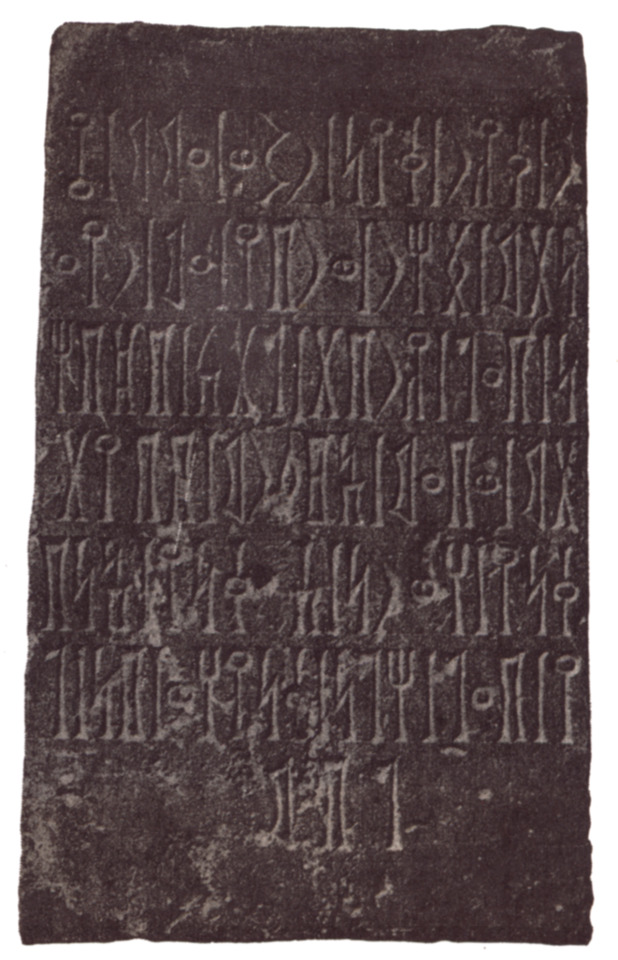
An example of Qatabanian script (wikimedia commons); no relation to cuneiform.
Finally, a handful of references to a more distant “relative”, Athrat, have been identified in texts from the kingdom of Qataban in Yemen dated to the second half of the first millennium BCE; she is thus separated from Athirat, Ashratum et al. by both a temporal and spatial gulf (A Reassessment…, p. 187). The available sources don’t provide much information about her. Two mention a temple she shared with Wadd, a local moon god, while another relays she received offerings alongside ‘Amm, the national god of the kingdom of Qataban (and possibly also a moon god). The nature of the precise connection between her and those two, and in particular whether she might have been viewed as the spouse of either of them, or even both (perhaps in different locations within the kingdom), is a subject of debate (A Reassessment…, p. 180-181). If she was, she might have been viewed as a solar goddess, though that remains uncertain (A Reassessment…, p. 186). The fact that it’s possible in some of the Qatabian inscriptions a structure is meant, and not a goddess, does not help much with the evaluation of the scarce evidence (A Reassessment…, p. 177-178).
“Genital center”: Asherah according to Barbara G. Walker
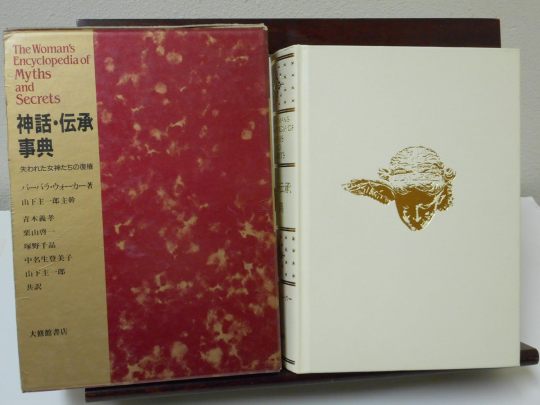
The Japanese edition of Walker's book (via an expired online listing with an asking price of 600+ USD [sic]; reproduced here for educational purposes only)
The previous sections more or less summarized what actual scholarship has to say about the term asherah and its cognates. However, with Megaten being Megaten, this is insufficient . No inquiry is complete without also consulting Atlus’ favorite publication: Barbara G. Walker’s magnum opus The Woman's Encyclopedia of Myths and Secrets.
Evidently not only Atlus is enamored with her writing - it has influenced a number of other popular Japanese franchises, especially Fate. It also has overwhelmingly positive reviews on Goodreads. There is a non-trivial number of people out there who find it credible, despite the author’s complete lack of relevant credentials, poor sourcing, and questionable at best methodology. Ironically, I have a strong suspicion that Walker herself might no share this view. I’d hazard a guess that this tome - and Walker’s numerous other less discussed New Age publications, including such smash hits as I-Ching of the Goddess - are a cynical grift, since she describes herself as an atheist elsewhere (sic). I digress though.
Walker’s book contains a total of 29 references to Asherah. She gets her own separate entry, but it surprisingly only occupies one page. To be fair, we have to bear in mind that in the early 1980s, when the book was written, the “Asherah boom” was only starting. Most of the entry is not particularly unique, and is limited to Bible-based speculation from before the discovery of the “Yahweh and his asherah” inscriptions, with a dash of Ugarit. Walker basically subscribes to the notion of a “tree goddess” wholesale, and adds that clearly the “groves” were a metaphor for Asherah’s “genital center”. She had to throw in something uniquely baffling, though, and speculates the name Asherah somehow goes back to Old Iranian asha, which she translates as “universal law” (for the actual meaning of this term, consult Encyclopedia Iranica). Further, she connects her with Isis at random, and asserts she was worshiped in Thebes as a result (The Woman’s…, p. 66).
Elsewhere in the book Walker simply rehashes questionable dated scholarship of the sort already discussed earlier. She proclaims Asherah and Baal a couple (The Woman’s…, 85); in Anat’s entry she treats her and Asherah as interchangeable and, inexplicably, also as the goddess of Jerusalem (The Woman’s…, p. 30). Astarte gets similar treatment (The Woman’s…, p. 69). This identification also gets an extended version which includes Aphrodite and Lucian’s Dea Syria as bonuses (The Woman’s…, p. 44). As far as I am aware, the identification with Aphrodite is a Walker original. She liked it so much it also pops up in Adonis’ entry, where she explains he was paired with “Aphrodite or Asherah” in Mesopotamian Mari (The Woman’s…, p. 10). This sort of complete disregard for temporal (Mari ceased to exist in Hammurabi’s times) and linguistic rigor is a mainstay of her work. Interestingly, Walker appears to be entirely unfamiliar with Ashratum, and instead asserts that the Mesopotamian counterpart of “Asherah” was Ashnan. She describes this name as Sumerian (The Woman’s…, p. 66). In reality, Ashnan’s name is Akkadian and means “grain”; the same goddess’ Sumerian name was Ezina - which, as you can imagine, also means “grain” (Julia M. Asher-Greve, Joan Goodnick Westenholz, Goddesses in Context: On Divine Powers, Roles, Relationships and Gender in Mesopotamian Textual and Visual Sources, p. 41). Needless to say, she had nothing to do with Ashratum.
Conclusions: Asherah, Athirat, or Ashratum?
With both the credible and questionable sources summarized, it is time to finally try to figure out who the “protagonist” of this article is supposed to be.
The translators of Strange Journey evidently concluded they’re dealing with the sort-of kind-of biblical figure. The assumption that’s who “Asherah” is supposed to be is common among English-speaking fans, and recently made it to her entry on the new Megaten wiki, which proclaims the discussed entity was “depicted as the wife of (...) Yahweh” (which, as I already pointed out, is at best a theory). As some of you might remember, in the past even I accepted it, and it was quite surprising to me that Atlus - with the well known love of dubious material, and a penchant for making everything revolve around YHVH which if anything only grew in more recent instalments - did nothing with this in Strange Journey. Or in any other game, for that matter.
I think the answer why that never happened is simple: “Asherah” was never meant to be who the romanization made her. It’s a case of mistaken identity.
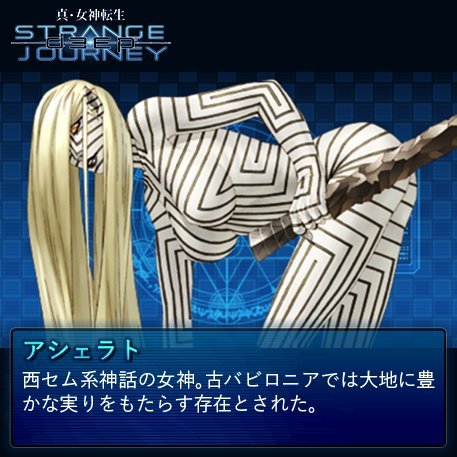
As demonstrated on the screencap above, the name used in the original game, as well as in SJR and subsequent SMT installments, is spelled as アシェラト in katakana. A quick search will demonstrate that the biblical term is actually rendered as アーシラト - that’s the spelling Japanese wikipedia uses, for instance.
Who is アシェラト, then?
While this might not be evident at first, apparently the conventional Japanese spelling of Ugaritic Athirat. Japanese Wikipedia claims so outright, though without providing sources. However, I think we can trust it in this case. Most of the relatively few non-Megaten results for アシェラト appear to come from Ugarit hobbyists, here is just one example; I can vouch for this person’s credibility, they are pretty clearly well acquainted with the primary sources and relevant scholarship.
This impression that Athirat, not Asherah, was the intended name is further strengthened by the romanization of the name used in Shin Megami Tensei Series 25th Anniversary Memorial Book: MegaTen Maniacs, a book released as a bonus with a limited edition of Strange Journey Redux (p. 133; thanks to @purseowner4thequalityanimation for directing me to it!):

This is far cry from Asherah, but remarkably close to the non-vocalized form of the Ugaritic Athirat’s name, aṯrt. However, the name is not all. The compendium entries also provide some clues. Her original one describes her as “a Semitic goddess who was the one to bring fertility to the Babylonian lands. She is known as the mother of the gods. It is believed that in Phoenicia, she became Astarte.” I’m not a huge fan of implying there ever was such a thing as a “Semitic pantheon” - only languages can be described as “Semitic”, deities, let alone a “religion”, not really (Michael P. Streck, Semites, Semitic in RlA vol. 12, p. 386-387) - but the information, by Megaten standards, is relatively rigorous. We get a mix of Ugaritic Athirat (“mother of the gods”) and Mesopotamian Ashratum (explicit reference to Babylonia), with the questionable conflation with Ashtart (Astarte is simply the Greek spelling of this name) I mentioned thrown in for good measure. No references to the Bible or the inscriptions which sparked the “Asherah boom” are present, though.
Perhaps most curiously, even if not ideal, the sources consulted were clearly of much higher quality than Woman’s Encyclopedia - which, in fact, seemingly didn’t have any impact on Asherah’s bio. Mashing Ashratum and Athirat together is questionable, much like mashing together, say, Zeus and Tyr based on the shared origin of their names would be, but it’s miles ahead of many other choices made by Atlus. SMT IV didn’t change much. She appears in an NG+ quest which presumably reflects Atlus’ love for unnecessary equations - in this case with Ishtar. The less said about that, the better.
When Asherah was later added to Dx2 - which for now is her final appearance in the series - she received a new compendium entry, which describes her as “a goddess from ancient Semitic religion, married to the Lord of the Mountains Amurru. She is thought of as the Mother of all Gods. As the goddess of love and fertility she was worshiped in ancient Babylonia. She is also known as Astarte in other religions.” Most of the information from the previous version returns, but we have a surprising case of doubling down on the reference to Mesopotamia - with a surprisingly accurate reference to Amurru thrown in. Once again, no trace of Yahweh, biblical cultic objects, or anything of that sort, though. Walker’s influence also cannot be detected. Later on, the Ugaritic material got an additional shoutout in Dx2 - with the advent of a feature letting the player turn spare demons into equipment, the option to turn Asherah into a sword with the ability “Lady of the Sea” was added. It should be noted that Dx2 later did throw the Bible into the mix, though - a craftable shield from the same update is named Asherah Pole, an obvious reference to the cultic objects discussed in the first section of the article. Still, I believe I’ve conclusively demonstrated nothing indicates that was the intent when the design was created for Strange Journey.
To sum up, ignoring the single outlier from Dx2, “Asherah” appears to be a mashup of the Ugaritic Athirat and Mesopotamian Ashratum - with the name clearly pointing at the former. That, at the very least, should be the romanization of it. I do think this adds a second layer of mistaken identity - Athirat and Ashratum have cognate names, but their character is dissimilar, and they were worshiped in different areas - but once again, the series has seen much worse.
My only problem with treating “Asherah” as Athirat is her design. It’s not that I necessarily dislike it (quite the opposite). It’s striking for sure, and its position as a fan favorite is well earned. I won’t delve into speculation whether the popularity boils down to Asherah being a large scantily clad woman covered in geometric patterns who’s easier to draw than fellow scantily clad large woman covered in geometric patterns Maya, and more prominent than fellow scantily clad and covered in geometric patterns (but not necessarily large) Cybele (who’s not in the base SJ which is beyond bizarre to me given that the game is a joyful tribute to Frazerian phantasmagorias by the way of Barbara Walker, but I digress). To be entirely fair, there isn’t really anything I could compare it to. No unambiguously identified iconographic representations of Athirat or Ashratum - let alone of the hypothetical “Asherah” - exist (A Reassessment…, p. 264). The so-called “pillar figures” are frequently labeled as “Asherah” (even in her wikipedia article), but for no particularly strong reason (A Reassessment…, p. 267).

Baal Cycle beach episode (personal screencap from 2021 or so; I do not recommend actually playing the gacha)
A question we should ask ourselves is whether it’s possible to imagine her playing her role from the Baal Cycle, given that it’s the most extensive source dealing with either Athirat or Ashratum. Despite never really adapting it, Megaten somehow managed to give us nearly the complete cast - and I would argue Baal, Anat, Yam, Mot and Attar all look like they could pull off their roles from this cycle of myths. How about “Asherah”? In theory she could, I suppose, though I personally would prefer Athirat to look visibly older, and somewhat less naked (I quite like this one). As the Mesopotamian Ashratum, the design would work perfectly fine, though. I will refrain from trying to evaluate whether the Old Babylonian official who called her the “mistress of voluptuousness and joy” would be fond of the contents of her pixiv tag, but I think her appearance represents this description pretty well.
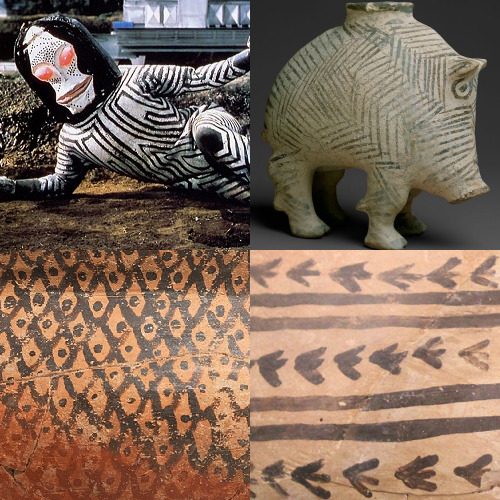
The alien Dada from Ultraman, an Elamite boar vessel (via MET) and two pieces of Halaf ware (wikimedia commons)
As a side note, while Asherah’s coloration and patterns ultimately simply reflect Kaneko’s enthusiasm for an abstract art themed alien from Ultraman (I suspect the size does too), they unintentionally(?) make the “heroine” of this article resemble painted pottery - which works well enough, I think.
Post scriptum: Asura in Strange Journey
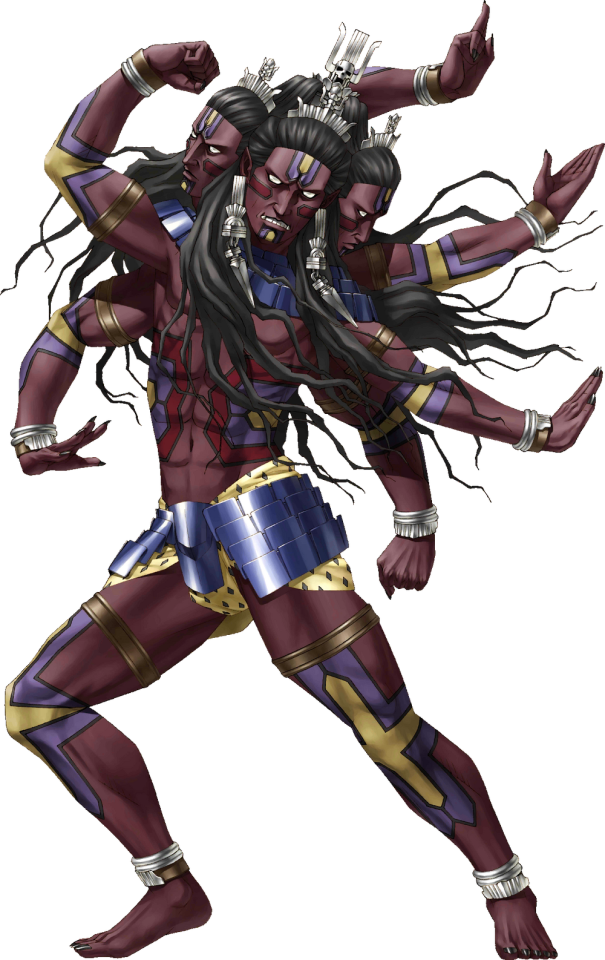
Asura, as portrayed in Strange Journey (MT wiki, via VeskScans) An article dealing with Asherah in Strange Journey - even one focused on different aspects of her role in the game - cannot leave out perhaps the most puzzling choice made during its development. I am referring, of course, to having Asura turn into her. Apparently a few years ago an assumption that Barbara G. Walker might be to blame was making rounds, though this is, surprisingly, entirely baseless (as documented here). My suspicion is that this has nothing to do with Asherah, and instead is a leftover of an earlier version of the game.
As revealed in the already discussed Megaten 25th anniversary book, Asura was initially supposed to turn into Ashur, the tutelary god of the city of Assur, and by extension Assyria as a whole (Megaten Maniacs, p. 133).
While there’s no deeper connection between the two other than a superficial phonetic similarity, presenting them as closely related is not actually not an invention of Atlus either. The notion that the Hindu Asuras have something to do with Ashur, or at least with Assyria more broadly, enjoyed some renown in the early decades of the 20th century, though even then wasn’t universally accepted (Hannes Sköld, Were the Asuras Assyrians?, p. 265-266). Today it is kept afloat largely just by all sorts of fringe websites, including but not limited to puzzling Hinduism-adjacent blogs and Atlantis truthers (are there people searching for the location of Hobbes’ Leviathan too?). Presumably, someone at Atlus found it in a similarly dubious source.
Ashur obviously didn’t make it into the actual game, and Asherah took his spot for some hitherto unknown reason. As per the same source (ie. Megaten Maniacs, p. 133), multiple other demons were replaced at some point in the game’s development. Interestingly, Ashur and Asura are the only case of only one half of a pair being replaced. Morax and Moloch were added as a replacement for Minotaur and Asterius, while Mithras and Mitra - for Asmodeus and Aeshma. Both of the scrapped pairs are closely related thematically: Asmodeus is a Jewish take on Zoroastrian Aeshma in origin; Asterius in this context was presumably intended as Minotaur’s actual given name (as given for example by Pausanias), and not one of the numerous other bearers of the same name in Greek mythology.
It sounds a bit as if some of the changes were done in a hurry. Going beyond the pairs, Ouroboros was supposed to be replaced by but they apparently failed to find someone appropriate - a figure with ma in the name who could take an “administrative role” among the mothers - on time (I think Ninimma would work - she has ma in her name, disputed claims of a “maternal” or “creative” role, and she clearly would work well as an “administrator” - but I digress). Even Mastema almost got replaced at the last minute. The developers apparently worried about his appeal to the potential audience, and considered replacing him with another angel, though no more precise information is provided. Given that he’s easily one of the most popular demons today this sounds pretty silly in retrospect.
Could it be that Asherah’s introduction was a last minute change like that? Perhaps Asura remained simply because there was no time left to design a more fitting demon to go with her (not that he was a particularly good match for Ashur in the first place)? These questions must remain unanswered, unless by some miracle more information about SJ development will emerge in the future, sadly. I feel obliged to point out that the Ashur case might've been a rare example of a situation in which Atlus could’ve instead just resorted to one of the series staples to make it more coherent. I’m talking, of course, about the persistent conflation of Asura and Ahura Mazda (as recently discussed by Eirikr here; note that even Asura’s SJ compendium entry brings it up).
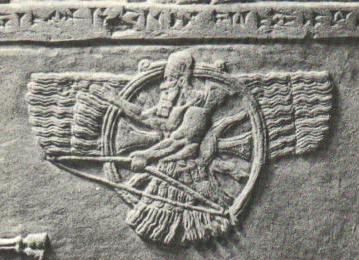
The Assyrian god inside a ring (wikimedia commons)

The Achaemenid figure inside a ring (wikimedia commons) A connection between Ahura Mazda and Ashur, while not directly attested, is a fairly common subject of speculation in scholarship up to this day. To be specific, a symbol common in Achaemenid art, a winged figure inside a ring, is argued to be a representation of Ahura Mazda patterned on earlier Assyrian depictions of a god usually interpreted as Ashur (Michael Shenkar, Intangible Spirits and Graven Images: The Iconography of Deities in the Pre-Islamic Iranian World, p. 47-50; note that identification with Shamash is also relatively common, though).

A possible eastern depiction of Indra-like Ahura Mazda (left) with Nanaya (center) and Weshparkar (right) from Dandan Oilik (wikimedia commons) While Zoroastrianism is, at least nominally, aniconic, historically especially in the peripheries of the areas inhabited by its adherents (like the Caucasus or the western frontiers of China) the borrowing of iconography from neighboring cultures was frequent. The possible Ashur-Ahura Mazda depictions have less ambiguous parallels involving the iconography of Zeus (in Commagene, in Bactria, and on Kushan coins; Intangible Spirits…, p. 61-62) and even Indra (in Sogdia, sometimes complete with elephant mount; Intangible Spirits…, p. 63) being adopted to represent Ahura Mazda. I guess Ronde gets the last laugh here: the bizarrely Zeus-like Ahura Mazda accidentally turned out to be pretty accurate.
142 notes
·
View notes
Text

06/28/2024
Me every morning.
___
JOKE-OGRAPHY: 1. In the Bible story leading up to this event, Jesus is asked by a synagogue official named Jairus to come heal his sick daughter. On the way, Jesus gets stuck in a big crowd, and by the time He makes it to Jairus's house, his daughter is dead. The folks there mourn until Jesus tells them the girl is just sleeping, then they ridicule Him. He tosses them out, and brings only the girl's parents and a few of His disciples inside. Then He takes the dead girl's hand and orders her to rise, and she comes back to life. Lastly, He asks that she be brought something to eat. 2. In this cartoon, we just see the part where Jesus calms Jairus's despair and brings the girl back, but instead of taking her hand, Jesus pokes her cheek. She comes back to life, though groggily, so He pokes her again and tells her that she has to get up. This interaction is based off my entire childhood of either waking up or being woken up by siblings. "Poke, poke, you have to get up, poke, poke, Mom said so, poke, poke."
AUTHOR'S NOTE: This is yet another "Tomics Resurrection," where I've taken an old cartoon, pale and still with death, and poked it until its color and breath returned. Like last week, this is a cartoon that's about a decade old now, and well overdue for a tune-up in my current style. In general, the last three panels remained the same in terms of dialogue and framing, with only the character designs and colors being updated. In the first panel, however, the original had a doctor scolding Jesus, while the resurrected version has Jairus, the girl's father, mourning for her. Jesus's smiling response to the doctor in the original is hence replaced with a very sober response to the sad father, and the dialogue is adjusted to reflect the new tone. How does it compare?

#catholic#christian#jesus#comic#cartoon#catholic memes#christian memes#jesus memes#tomics#bible#tomics comics#tom gould#jairus#jesus pesters a kid into waking up
421 notes
·
View notes
Text






THEODOR HILDEBRANDT - THE MURDER OF THE SONS OF EDWARD IV, 1835
This is a painting based on Shakespeare’s play, King Richard III. It depicts a scene of the two sons of Edward IV sleeping (Edward V and his brother Richard), secure in each other’s arms with a Bible and rosary by their side. Two figures, presumably assassins or murderers, are shown peering over the bed, observing the innocent, sleeping children. These figures are meant to represent the agents sent by Richard III to eliminate any rival claim to the throne.
Hildebrandt captures the hesitance of the murderers. Despite their grim task, there's an evident hesitation or moral conflict depicted on their faces, reflecting the unexpected reaction of the "unscrupulous murderers" before they carry out the deed as described in Shakespeare's play. This hesitation adds a layer of dramatic tension, highlighting the innocence of the boys against the backdrop of political brutality.
The viewer is placed as though standing directly next to the bed where the two young princes lie asleep. This close proximity establishes an instant, deep connection with the setting. The viewer becomes a nearly silent observer of the looming tragedy, intensifying the feelings of voyeurism, intimacy, and complicity. This setup makes the viewer feel as though they are part of the moment, heightening the emotional stakes.
The painting refers to an event from the Wars of the Roses, where Edward V and his brother Richard were last seen in the Tower of London in 1483. Their disappearance and presumed murder are central to the narrative of Richard III's usurpation of the English throne. The exact fate of the princes remains a subject of historical debate and mystery, but this painting visualizes one popular interpretation of their end.
The Düsseldorf School was famous for its focus on intricate, lifelike representations of scenes, frequently concentrating on historical or literary themes. Hildebrandt's painting illustrates this with its careful focus on detail, from the fabrics of the bedding to the emotions visible on the characters' faces. The school's training in drawing, anatomy, and landscape painting contributed to Hildebrandt's ability to create works with a high degree of realism, enhancing the emotional and dramatic impact of his paintings.
177 notes
·
View notes
Text



ㅤㅤㅤVampirism: My Monster High Dr Edition

ִֶָ. ..𓂃 ࣪ ִֶָ🦇་༘࿐ An intro on how vampires operate in my Monster High Dr





Vampire Hierarchy
⁺‧₊˚ ཐི⋆♱⋆ཋྀ ˚₊‧⁺ Vampires in this reality (as do many others) operate under a hierarchy. My father, Dracula, being at the top with fledglings at the bottom. In order it goes: Dracula, Royal Family (relatives of Dracula) Vampire Council, Vampire, Fledgling.
Vampires have different powers based on their hierarchy level, Dracula and his relatives are the most powerful whilst fledglings being the weakest.
ㅤㅤㅤㅤㅤㅤㅤㅤㅤㅤㅤPowers & Abilities
‧₊˚ ཐི⋆♱⋆ཋྀ ˚₊‧⁺ Here are the abilities that all vampires have regardless of their rank: levitation, immortality, regeneration, super speed, heighten senses, heighten durability, agility and endurance, telepathy, turning into a bat, and super strength. It is important to note that abilities have to be developed and strengthened over time, no vampire is born/made with the ability to perform these powers perfectly. The older, the better the vampire can use the ability.
These are the abilities that only Dracula can have: control animals and the weather, manipulate memories, shapeshift, necromancy. and fly.
The Royal Family can only use these abilities: hypnosis, psychometry, pyrokinesis, psychokinesis, turning others into vampires. (It is important to note that Dracula can do all of these things as well.)
Vampire Council: Unfortunately they don't have any special abilities they are just really old vampires.
Vampires: All the basic abilities.
Fledglings: All the basic abilities (except for turning into a bat) however they are all pretty weak at first and will have to be strengthened over time.
ㅤㅤㅤㅤㅤㅤㅤㅤㅤㅤㅤㅤ Weaknesses
‧₊˚ ཐི⋆♱⋆ཋྀ ˚₊‧⁺ All vampires are susceptible to these weaknesses, however the older you are (and depending on your rank) you may not be as vulnerable. For example a stake to the heart will not kill Dracula but it will kill a fledgling and it has the potential to kill a vampire.
Sunlight: Doesn't immediately kill a vampire instead it would just give them some serious sunburn, sickness, and restriction/weakening of their powers. However vampires can wear sunscreen, glasses, cool clothing, and carry a parasol to protect them from the sunlight. Now older vampires won't be affected as much like young vampires but it is still good to take precautions. Dracula is completely immune to the sunlight.
Stake to the heart: Will kill any type of vampire, technically, but it is possible to survive one depending on how deep they stab you and how old you are as a vampire.
Silver bullets: Wouldn't really do anything to a vampire because vampires here aren't really affected by silver perhaps a fledgling but not like an average day vampire.
Garlic: Won't kill a vampire it's more like an allergy for them. Garlic has a very strong smell that is not pleasing to vampires, vampires can also consume it here but it's more like a lactose intolerance thing than a lethal one.
Starvation: One of the three guaranteed ways to kill a vampire. Although older vampires don't need to consume blood as much as the younger ones do. (1/3 guaranteed ways to kill a vampire.)
Decapitation: Will kill any vampire, like duh! This is because the body can't regenerate and you cut it away from it's life source. (2/3)
Fire: Burning up a vampire will do the trick because I mean yeah what wouldn't? (3/3)
Religious symbols: Don't work in fact many vampires like them. Crosses, holy water, the bible none of that would work. Religious symbols would only work if the vampires themselves were religious, but since 99% of the time they aren't they don't work.
Being invited into places: That's more like a mannerism custom thing; here vampires can go into a place uninvited but most of them won't so its good to invite one anywhere.
Running water: Yeah that doesn't do shit here.
Mirrors: Yes vampires can see their reflection. The real world reason why vampires cant see their reflection is because old mirrors were backed with silver so it burned up their reflections, but since silver doesn't do anything then we can see our reflections. Fledglings however couldn't because they are actually vulnerable to silver.

This is just the basic rundown on vampires in my Dr, if you want the lore...that's for another day! Oh how I love vampires :]

#I love vampires so much#I have like three vampire Drs...so far#ask me about vampires#I want to talk about vampires#Dr intro#reality shifting#desired reality#shiftblr#shifting realities#shifting content#desired realities
73 notes
·
View notes